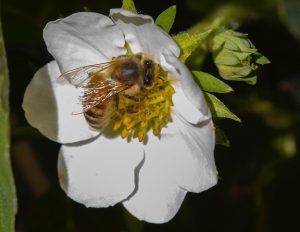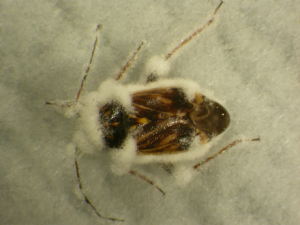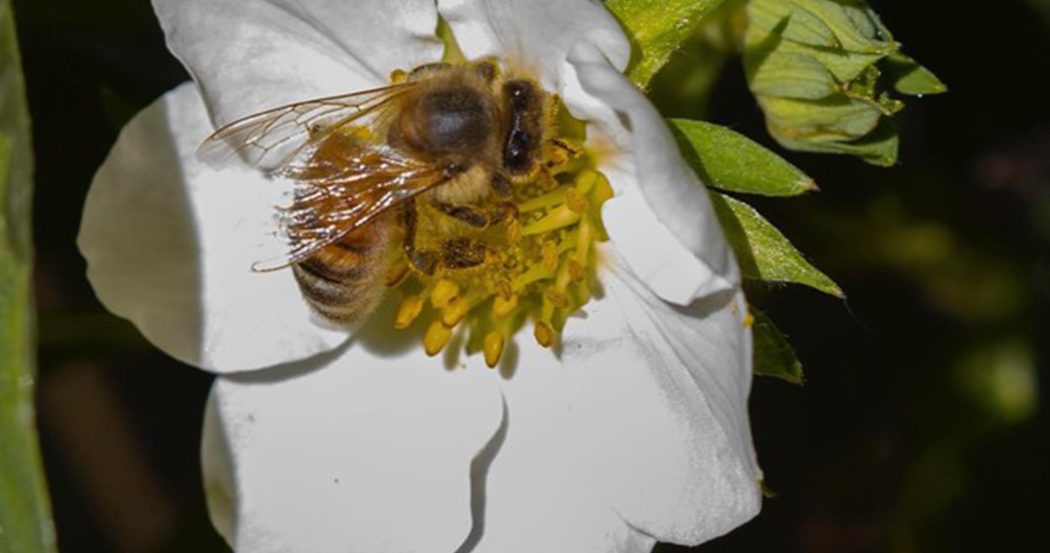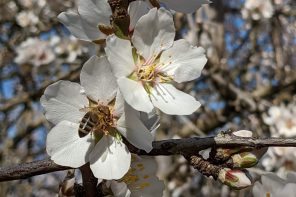How Bees Carrying Fungi are Protecting Agroecosystems Part 1
By: Charlotte Coates et al.
In recent years, the global decline in pollinator populations has received a great deal of media attention. Since the 1970s, the decline of bees has been increasingly associated with pesticide use in agriculture, as well as other factors such as habitat destruction and climate change. Pollinators play a crucial role in human food production that is mutually beneficial for the pollinators and crops. In many agricultural systems, managed pollinators such as honey bees and bumblebees ensure an abundant harvest. An innovative technology, apivectoring, uses the symbiotic relationship between bees and crops to improve the health of both crops and pollinators.
As managed bees fly from flower to flower, collecting nectar and pollen, they may pick up nasty hitchhikers, such as pathogenic microbes, which can cause harm to their colony and other wild pollinators, or may spread diseases throughout an agroecosystem. On the other hand, managed bees also supply pollination services and can even bring along friendly hitchhikers such as beneficial microscopic fungi that protect crops from pests and disease.
Employing the natural enemies of a pest or disease organism that harms crops can be part of a farmer’s arsenal of crop protection tools. These natural enemies, referred to as biological control agents, can include fungi, parasitic wasps, nematodes, and viruses. Biological control agents are an increasingly popular alternative to chemical crop protectants that can deteriorate ecosystem health and drive pesticide-resistance in pests.
Fungi are commonly used biological control agents as they are already naturally found on farms and can be highly effective against both pests and disease. Soil fungi can control pests by growing directly on them, simultaneously using mechanical pressure and enzymes to weaken the target insect’s outer coat, allowing the fungus to penetrate the cuticle and kill the host after colonization. This multi-pronged attack greatly decreases the chance of pest and disease resistance when compared to chemical pesticide methods.

Figure 1. A honey bee vectoring biological control agent to a strawberry flower. Photo credit Lorne McClinton, used with permission.
Apivectoring: Innovating agricultural systems
While biological control agents have slowly become more commonplace in organic and IPM programs, their application method has mimicked traditional crop treatments using spray and soil applications. Why not use the same pollinators that are already visiting every flower to do the farmers’ work and protect the crops from disease? Apivectoring uses managed pollinators as vectors to distribute biological control agents, particularly fungi, which are small enough to be easily carried by honey bees and bumble bees. Figure 1 shows a bee visiting a strawberry flower dusted with fungal spores to protect against grey mold. Figure 2 shows a dead Lygus bug killed by infection of the soil-fungus Beauveria bassiana.
Besides improving the agroecosystem for both plants and pollinators, apivectoring also supplies economic benefits to farmers. It can lead to increased profits by producing a higher quality and quantity of crops due to the joint services of pollination and biological control agents2, reduced fuel and water use, and decreased use of heavy machinery. Apivectoring is also efficient. Smaller amounts of biological control agents can be directly delivered to flowers where they are needed, thanks to the bees. Apivectoring uniformly distributes biological control agents and provides continuous crop protection during flowering, translating to an economically efficient crop protection method.

Figure 2. Each dead Lygus was kept on moist filter paper in a Petri dish and stored in the dark for 7 days to monitor disease (mycosis). The dead Lygus with white mycelia growth were scored as killed by the soil fungus B. bassiana. Photo credit: Peter Kevan, used with permission.
Importantly, apivectoring is an option in both conventional and organic farming. The implementation of apivectoring has occurred worldwide, in the Americas, Europe, Australia, New Zealand and Kenya. There is a multitude of tested crops that benefit from apivectoring. Notably, fungi carried by bees prevent serious mold growth on strawberries, raspberries, and blueberries. Apivectoring works well in greenhouses with bumble bees and has successfully targeted pathogens and insect pests on greenhouse-grown tomatoes and peppers. Other crops protected by apivectoring include field oilseed products such as sunflowers and canola. Apivectoring can also be used to fight coffee berry borer and other coffee pests, as proven in studies from Brazil and Mexico.
Registration of biological control agents for use in apivectoring has begun in several countries due to the thorough work of researchers showing that this technology is safe for insect vectors, the environment, and human consumption. Government input and support is needed to implement apivectoring technology and its many benefits.
In 2019, the First International Advanced Course on Using Managed Pollinators for Dissemination of Biological Control Agents for Suppression of Insect, Fungal and Other Pests of Crops was hosted at the University of Belgrade, Serbia. The course was co-sponsored by the International Commission for Plant-Pollinator Relationships (ICPPR) which has significantly contributed to the research and development of apivectoring technology. The ICPPR assembled apivectoring experts from around the world to share their findings and methods using this novel technology. Their collaborative effort will hopefully result in the successful adaptation of apivectoring into farming communities globally.
How will apivectoring impact beekeepers? In addition to honey and crop pollination, in the future, beekeepers will be able to offer farmers crop protection through apivectoring. As the bees are very efficient at delivering biological controls, most crops only need a low hive stocking density. The expertise of beekeepers will be needed to maintain the beehives and manage the biological control agents. A bonus to beekeepers is that preliminary studies suggest that the health of honey bee colonies could also benefit from apivectoring.
At the University of Guelph in Ontario, Canada, the Peter Kevan Lab is currently investigating apivectoring to crops and into honey bee hives using biological control agents already approved for use on crops. For those interested in learning more about apivectoring, please contact the International Organisation for Biological Control (IOBC), the International Commission for Plant Pollinator Relations (ICPPR) (https://www.icppr.com/), the Peter Kevan lab website (link) or visit the Weston Project website (https://www.facebook.com/2020BeeVectoring).
References
1.Intergovernmental Science-Policy Platform on Biodiversity and Ecosystem Services I. Assessment Report on Pollinators, Pollination and Food Production. 2016 Dec 7. https://zenodo.org/record/3402857. doi:10.5281/ZENODO.3402857
2.Kevan PG, Menzel R. The plight of pollination and the interface of neurobiology, ecology and food security. Environmentalist. 2012;32(3):300–310. doi:10.1007/s10669-012-9394-5
3.Smagghe G, Boecking O, Maccagnani B, Mänd M, Kevan PG. Entomovectoring for precision biocontrol and enhanced pollination of crops. Springer International Publishing; 2020. doi:10.1007/978-3-030-18917-4
4.Espinosa, S.S., Andrés Sánchez, A., Kevan P.G. and Figueroa JR. Tecnología Apivector: origen, componentes y desarrollo. CienciAgro. 2018;1:42–57.









